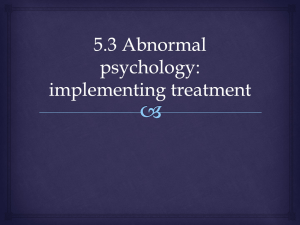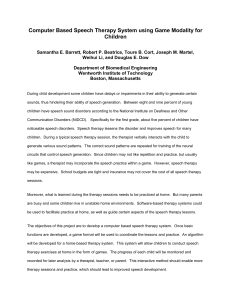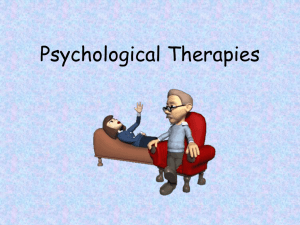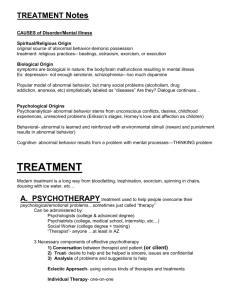AP Psych-Unit 12-PPT
advertisement
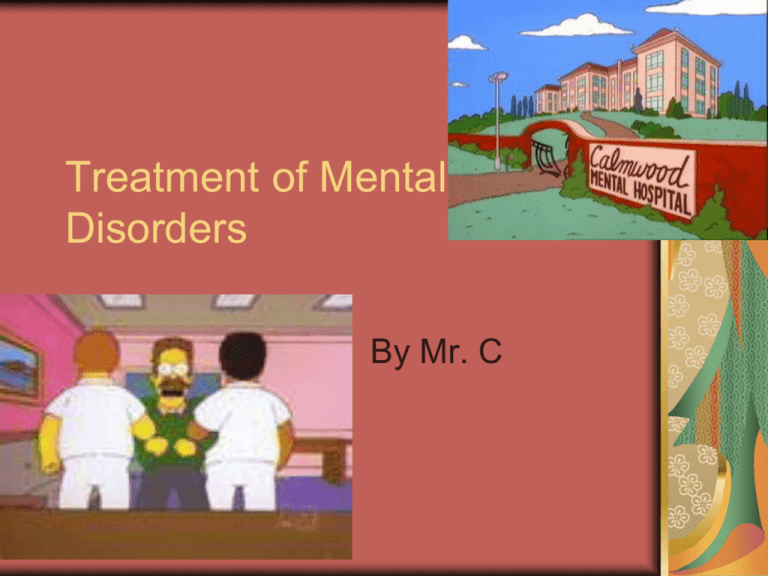
Treatment of Mental Disorders By Mr. C Key Questions for this Unit What’s the difference between a Psychiatrist, Clinical Psychologist and a Counselor? How do Psychoanalysts treat mental disorders? How do Behaviorists treat? How do Humanists treat? What is Cognitive therapy? What is a psychiatrist? Psychiatrists are MDs (medical doctors) with a specialty in treating mental disorders, usually with a biomedical therapy (medicine) and some talk therapy. You would see a “shrink” if you have schizophrenia, severe depression, suicidal thoughts, and other severe mental problems that need medication. What is a clinical psychologist? A clinical psychologist has a PhD in psychology (no medical school). They treat fairly serious mental illnesses with “talk” therapies. They might treat personality disorders, anxiety disorders, addictions using insight or “talk” therapy. What is a counselor? A counselor uses “talk” therapy to treat non-mental disorders like improving communication between family members, grief counseling, marital counseling, life strategies. Counselors have a Masters Degree with specialty training. 2. In contrast to a clinical psychologist, a psychiatrist is more likely to a) engage in an eclectic b) use a biomedical/somatic treatment c) recognize the importance of group therapy with patients having the same disorder d) treat clients in community mental health centers exclusively Perspectives on Treatment Psychoanalytic Behavioral Humanistic Cognitive Biophysical What are Psychoanalytic methods? Dream Analysis – Manifest content (actual content) AND Latent content (hidden) Transference – strong emotional outburst/connection with therapist Hypnosis Free association – talk about whatever and Dr. analyzes it All 5 rely on exposing unconscious thoughts and interpreting them. VII. Psychoanalysis (psychodynamic): Unconscious thoughts & emotions are brought into awareness to be dealt with. Psychological problems – the result of unconscious processes. Bringing unpleasant unconscious thoughts into to consciousness, produces catharsis. A. What are Psychoanalytic methods of therapy (4 of them on same card if possible): 1. Free Association – patient reports anything that comes to his/her mind. The psychoanalyst takes whatever you say and treats it like a window into your unconscious mind. B. Dream analysis: Dreams have two types of content: Manifest content- actual events in dream. Latent content – hidden message in dream. (latent = hidden) Freud thought that each dream represents a form of wish fulfillment. The wish may be disguised, but it is always there. C. Transference Feelings of love or other emotions (hatred) are expressed toward the therapist. These feelings are actually unconsciously felt toward others; the patient is projecting these feelings onto the therapist. This provides clues about the client’s feelings about these other people. Hypnosis Hypnosis is a psychoanalytic therapeutic technique. Some people are more susceptible to hypnosis than others – can’t by hypnotized against your will. Whatever you think, patients report benefits from hypnosis. video 5. The goal of psychoanalytical therapy is a) to change maladaptive behavior to more socially acceptable behavior b) to change negative thinking into more positive attributions c) to attain self-actualization d) to bring unconscious conflicts to conscious awareness and gain insight In psychoanalysis, an emotional attachment to the therapist that symbolically represents other important relationships is called a. resistance. b. transference. c. identification. d. empathy A psychoanalyst who believes in the theories of Freud would see mental disorders as caused by a. birth trauma. b. repressed sexuality and aggression. c. bizarre dreams. d. immature personal relationships. Psychoanalysis summary What causes mental disorders? – unconscious (whatever) Treatment? – Probing the unconscious mind (psychoanalysis) Behavioral Therapy Behavioral causes of disorders? Behaviorists believe that mental problems are caused by classical conditioning (for example, phobias), operant conditioning (addictions, depression), and observational learning (we watch our parents and friends suffer so we copy them). Treatment: they change maladaptive behavior. What are classical conditioning techniques? Systematic desensitization (gradual exposure) to your phobia or germs (for OCD and phobias) Flooding – overexposure to what bugs you Aversive conditioning – associate bad things with your maladaptive behavior (shock testicles) video Operant conditioning treatment Token economy – (operant conditioning) Therapists will reward desirable behaviors with a reward system. This is usually applied to groups like hospital mental wards or classrooms or workplaces. Systematic desensitization is a technique based on a) classical conditioning b) instrumental conditioning c) operant conditioning d) aversive conditioning The owner of a chicken ranch ends a pet dog's habit of stealing and eating eggs by allowing the dog to "find" and eat several eggs laced with Tabasco sauce. The ranch owner's approach is similar to a. covert sensitization. b. aversion therapy. c. implosive therapy. d. desensitization techniques. Behaviorism summary What causes mental disorders? - We are conditioned to be sick (classical, operant, observational learning) Treatment? We change the behavior through conditioning. Humanistic Perspective of Psychology Humanism What is the root word of Humanism? After years of psychoanalysts saying we are a bunch of id-driven animals and years of behaviorists studying rats in a cage, the Humanists came along in the 60s. What is Humanism? Major perspective of psychology. Focuses on maximizing human potential, free will. Important people: Carl Rogers, Abraham Maslow. Humanistic therapy? Who is Carl Rogers? Carl Rogers was the founder of person-centered therapy, reflective listening, unconditional positive regard, empathy. The patient/client has all the answers and the means to treat themselves. In personcentered therapy, the therapist acts as a sounding board for the patient, sometimes rephrasing what the patient says (reflective listening). Empathy is important! Reflective listening Patient to Rogerian therapist: I’m really depressed. Therapist: I see. Yes. You are depressed. Patient: Nothing is going well. Therapist: Nothing well. Patient: I feel like killing myself. T: You’re thinking of killing yourself. P: Yes, I’m going to do it NOW. T: You want to do it now. P: [Jumps out window.] T: Woosh. Splat Person-Centered Therapy (Client-centered or Rogerian) Show the client unconditional positive regard: accepting and valuing self (and people) regardless of their behavior Allow the client to take responsibility for his life Mirror the clients emotions and thoughts so that he/she can decide their path in life Be congruent (honest, genuine, vulnerable) Show empathy Maslow’s hierarchy of needs Maslow’s hierarchy of needs People cannot maximize their potential unless their more basic needs are met. If a family’s home just got destroyed by a tornado, can they focus on their communication skills? If you are hungry, can you worry about your self esteem? Humanistic Therapy Humanists are really touchy-feely, but without them we are just rats in a cage. Rogers and Maslow put the “human” element back into psychology and therapy. Their philosophy: We are all humans striving to maximize our potential. A therapist’s job is to remove obstacles to self-actualization. Humanism treatment summary What causes mental disorders? Barriers to self actualization. How to treat mental disorders? Person-centered therapy, reflective listening, unconditional positive regard. Vic is encouraged to take charge of the therapy session and his therapist uses an active listening approach to mirror back the feelings he hears from him. Which therapy is most likely being described? a) client-centered therapy b) cognitive therapy c) psychodynamic therapy d) existential therapy When a therapist attempts to see the world through the client's eyes and to feel some part of what he or she is feeling, the therapist is using a. authenticity. b. empathy. c. reflection. d. ego-centering. A therapist that engages in reflective listening, non-directive therapy, and has unconditional positive regard for the client is probably a. cognitive b. behavioral c. humanistic. d. psychodynamic What is cognitive therapy? Cognitive therapy focuses on changing how the client/patient thinks. The therapist focuses on changing/fixing the maladaptive thoughts of the patient It can be confrontational Cognitive therapy also “educates” the client, teaches him/her proper behaviors/thoughts Cognitive perspective We are depressed because we are irrational. Our expectations are too high and misplaced. We want everyone to love us and accept us. We want every thing to go our way. We stay angry about stuff that happened a looong time ago. WE MUST CHANGE THE WAY WE THINK TO BE HAPPY AND SUCCESSFUL. Who are famous cognitive therapists? Aaron Beck – reality therapy Albert Ellis – rational emotive therapy Aaron Beck? Cognitive therapy Distorted thinking has a negative effect on our behavior no matter what type of disorder (Aaron Beck, 1997). Albert Ellis Rational Emotive Behavioral Therapy vigorously challenges people’s illogical, self-defeating attitudes and assumptions; a confrontational therapy Rational Emotive Therapy: Ellis A-B-C theory of dysfunctional behavior A – Activating event B – Belief C – emotional Consequence based on that belief. Example of Rational Thinking A= fail a midterm examination B=It’s unfortunate that I failed-I did not study hard enough and I must make sure that I study harder for the final C=no consequences (no emotional disturbance) Example Irrational Thinking: leads to Emotional Disturbance A= Fail exam B= I’m stupid, I’ll never be able to pass this course and I will fail this course C=depression Rational Emotive Therapy Identify patient’s irrational beliefs Add “D” and “E” to A-B-C theory Teach the patient to Dispute the beliefs and substitute logical and rational beliefs Evaluate the effects of disputing their irrational beliefs CBT: Effective for Which Disorders? Empirically supported treatment for Depression Generalized anxiety disorder Obsessive compulsive disorder Panic disorder Cognitive summary What causes mental disorders? Irrational thoughts and beliefs How to treat disorders? Change the thoughts and beliefs In rational-emotive therapy, a.clients are encouraged to take responsibility for their own choices. b.clients learn to challenge irrational beliefs. c.the therapist seeks to have the client discover rational insights on his or her own. d.irrational elements of the unconscious are made to conform to reality. One difference between psychoanalytic and cognitive models of treatment is that cognitive therapists A. Say little during sessions B. Emphasize the primacy of behavior C. Focus on the present D. View repressed thoughts about one’s childhood as the root of most problems E. Do not face their clients Who would suggest that cognitive distortions or errors in logic that are blown out of proportion could lead to psychological disorders? A. Sigmund Freud B. Ivan Pavlov C. Carl Rogers D. Aaron Beck E. Tommy Chong Eclectic therapy? – uses tools from cognitive, behavioral and humanistic perspectives Group Therapy Benefits of Group Therapy? Is cheap, effective. (only 1 professional is needed) It allows people to gain insight into their own behaviors and thoughts People don’t feel like they are the only one with their problem; they can witness the therapist treat others with similar problems. You can cure yourself while curing others. All of the following are potential benefits of group therapy EXCEPT a) it is often more economical than 1:1 treatment b) it does not require the services of a mental health professional c) clients with similar problems can provide helpful insight and feedback to peers d) group members can see how their problems might impact others What is the biomedical approach to treatment? Drugs, surgery, ECT Types of drugs? Antipsychotics – (schizophrenia) can lead to tardive dyskinesia Antidepressants – (Prozac, Zoloft, Wellibutruin) Antianxiety – can lead to drowsiness (Xanax, Paxil) Somatic therapy (Drug Therapy) Antipsychotic drugs alleviate the symptoms of severe disorders such as schizophrenia; Examples:Thorazine, many work by blocking dopamine receptor sites Can lead to tardive dyskinesia, (tremors) Drug Therapy Psychopharmacology – The prescribed use of drugs to help treat symptoms of mental illness ostensibly to ensure that individuals are more receptive to talk therapies Drug Therapy Antidepressants and mood stabilizers Include Prozac, monoamine oxidase (MOA) inhibitors, lithium carbonate is a mood stabilizer (effective against bipolar disorder) Treat depression and bipolar disorder Usually affect serotonin and/or norepinephrine SSRIs block the reuptake of serotonin between 2 neurons Drug Therapy Antianxiety drugs work by depressing central nervous system activity Most common side effect - drowsiness highly addictive, can be fatal when mixed with alcohol sudden cessation after long-term use can result in severe withdrawal symptoms, including seizures, increased anxiety, and in rare cases, death Xanax, Paxil Drug Therapy in ADHD Stimulants suppress activity level in persons with attentiondeficit/hyperactivity disorder (ADHD) There is controversy from concern that the causes and boundaries of ADHD are vague and the potential exists for overdiagnosis _______ is any technique involving surgical alteration of the brain. a. Ablation lesioning b. Psychosurgery c. Deep ECT d. Psychic surgery 4. The MOST commonly cited side effect associated with anti-anxiety drugs is a) insomnia b) blurred vision c) drowsiness d) tachycardia 9. Prozac and other modern antidepressant medications work to a) block dopamine receptors b) decrease the level of acetylcholine c) break down the MAO enzymes d) block the reuptake of seratonin 11. Valium is a) an antidepressant drug b) an MAO inhibitor c) an antipsychotic drug d) an antianxiety drug Psychosurgery Psychosurgery – The general term for surgical intervention in the brain to treat psychological disorders The infamous prefrontal lobotomy is no longer performed Severing the corpus callosum, however, can reduce life-threatening seizures Brain-Stimulation Therapies Electroconvulsive therapy ECT is used for the treatment of severe depression Transcranial magnetic stimulation, a possible alternative to ECT, can also be used for the treatment of depression, schizophrenia, and bipolar disorder Transcranial magnetic stimulation Video 1930’s-1950’s Frontal lobotomy Became Prefrontal lobotomy Muniz won Nobel prize for procedure Procedure eventually banned Destruction of personality Replaced in 1954 by first antipsychotic: Thorazine Treating disorders with drugs or surgery is known as a. cognitive therapy b. humanistic therapy c. biomedical therapy d. psychoanalysis Carl Rogers is responsible for a. client-centered therapy. b. psychoanalysis. c. directive therapy. d. existential therapy. A. B. C. D. The aim of cognitive-behavioral therapy is to _____ Discover unconscious motives for behavior Change the way people behave Change the way people think and behave Change people’s negative thinking patterns A. B. C. D. Ann is suffering from depression and no psychological or drug therapies are working to alleviate her symptoms. The biomedical technique of ____ may be used as a last resort. Flooding Systematic desensitization Electroconvulsive therapy psychosurgery Modern antidepressants, such as Prozac, work to block the reuptake of which neurotransmitter? A. Dopamine B. Serotonin C. Acetylcholine D. GABA A. B. C. D. E. John is a 12-year-old who is having trouble dealing with his family’s relocation to a new city. He most likely first sees a ______ Psychiatrist Counselor Clinical psychologist Registered nurse Psychoanalyst In aversion therapy a person __________ to associate a strong aversion with an undesirable habit. a. knows b. learns c. wants d. hopes

